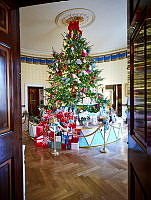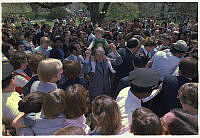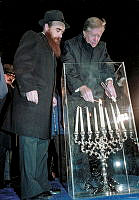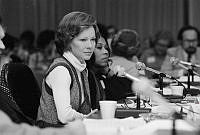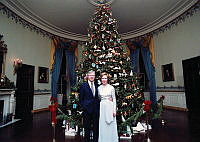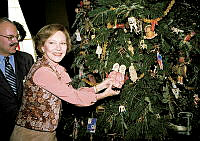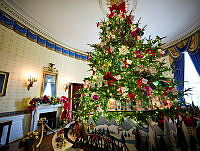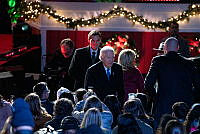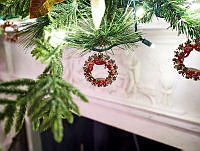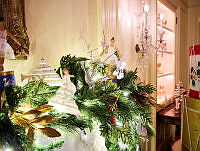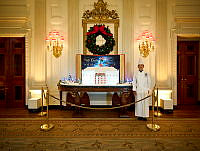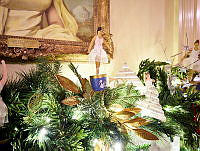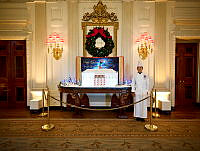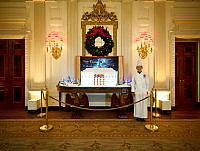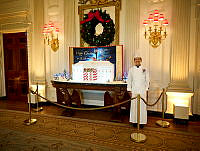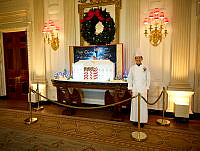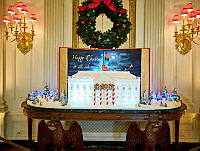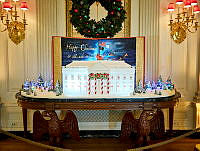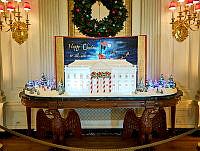Rubenstein Center Scholarship
White House Thanksgiving Turkeys in the Roaring '20s
Generosity of the American People in the 1920s
First families received turkeys as gifts long before the 1920s. Horace Vose, the “Poultry King” of southwestern Rhode Island, first sent one of his prized birds to President Ulysses S. Grant in 1873, and continued to furnish White House Thanksgiving and Christmas tables for forty years.1 Yet in the 1920s, true to its reputation as a fast-paced era that saw major technological and cultural change, the turkey gift tradition became national news.
In 1920, President Woodrow Wilson spent his last Thanksgiving in the White House. The presidential election had been decided a few weeks earlier, but another contest took place on the White House lawn: a “spirited battle” between the two turkeys sent to Wilson that year.

The first, a 38-pound bird from the Chamber of Commerce of Cuero, Texas, had traveled to Washington in a coop reportedly modeled after the White House.2 The second contender was sent to Wilson by South Trimble of Kentucky, clerk of the U.S. House of Representatives. The turkeys tussled outside the White House and, while neither received grievous injuries, the Kentucky turkey prevailed. He enjoyed a victory strut around the lawn, but the real winner was President Wilson, who later enjoyed a hearty Thanksgiving meal.3
While Wilson’s turkeys fought it out, a third turkey made its way to president-elect Warren G. Harding, who spent the holiday in the Panama Canal Zone that year. The turkey, a gift of the Harding Girls’ Club of Chicago, traveled in a Pullman railcar to New Orleans and made the rest of the trip by boat. 4 The club furnished Harding’s turkeys for the next two years, sending them on exciting cross-country trips that captured national attention.
Supreme II, named after his predecessor, made his way to the White House by airplane in 1921, at a time when flight was still a novelty for many Americans and delivery of letters and packages via air mail had only recently begun. The turkey traveled in style, “wearing an aviation helmet and goggles and clad in a black and gold sweater held on by a pink bow” that the girls in the club had knit, according to the Baltimore Sun. 5 But turkeys are not well suited for flight—air mail or otherwise—and the trip ended early when Supreme II became air sick. The turkey made the rest of the trip to the White House by train. 6

Turkeys sent to President Warren G. Harding in the early 1920s traveled in style. This battleship turkey crate arrived at the White House in 1921.
A Texas turkey sent to the White House the same year made a similarly splashy arrival, but this time sent a political message. The Cuero Chamber of Commerce turkey traveled in a crate that resembled a battleship, complete with turrets, guns, and decorative flags. Harding was participating in the Conference for the Limitation of Armaments at the time, which dealt with, among other things, the possibility of scrapping U.S. battleships. 7

A group of people pose outside the White House with "Supreme III." The turkey was a gift from the Harding Girls’ Club of Chicago in 1922.
In 1922, Harding’s last Thanksgiving at the White House, the Chicago girls sent another turkey on a wild ride. Supreme III, who the girls fattened on chocolates, took a sensational, record-breaking road trip. He traveled more than 800 miles in just under 38 hours, and like his predecessors made the national news. The Atlanta Constitution noted that turkey had traveled comfortably, in “a motor coat was made especially for him” and an “extra large cage, suspended by and set on springs, to prevent too much shake-up on the trip.” 8
Harding died in office in August 1923, and his successor, Calvin Coolidge, celebrated his first official White House Thanksgiving in November of that year. Coolidge took a different approach to the holiday. He discouraged the turkey gift tradition, instead opting to buy local. “Sometimes enough turkeys have been received at the White House to load down the tables of the whole staff,” reported the New York Times, “Mr. Coolidge does not regard the practice as one that should be encouraged.” 9

Thirteen-year-old Girl Scout Leona Baldwin shakes hands with Grace Coolidge outside the Tivoli Theatre in Washington. Baldwin prepared a Thanksgiving luncheon for the Coolidges in November 1925.
In the following years, however, Coolidge’s resolve gave way to custom, and the White House received its usual influx of holiday birds. “Coolidge to be Sure of His Dinner,” a Los Angeles Times headline read in 1925, as “the generosity of the American public [was] more than taking care of the needs of the Executive household.”10 At the beginning of November 1925, the Coolidges also received an early Thanksgiving meal thanks to thirteen-year-old Vermonter Leona Baldwin who, with the assistance of nineteen other Girl Scouts, prepared a luncheon for the president and first lady. From the headquarters of the Girl Scouts that once stood on White House property, Leona served a turkey that had been raised on her family’s farm. 11
Turkeys were not the only game sent to the White House for Thanksgiving. Throughout his presidency Coolidge received quail, ducks, geese, rabbits, and once even a deer. But when a raccoon arrived at the White House in time for Thanksgiving in 1926, Coolidge hesitated. He had never eaten raccoon meat, and despite assurances of the animal’s “toothsome flavor,” he declined to give it a try. The raccoon met a very different fate: it became the Coolidges’ pet. 12

First Lady Grace Coolidge holds her pet raccoon, Rebecca, which was sent as a gift to be on the Thanksgiving menu.
Library of Congress, National Photo Company Collection












